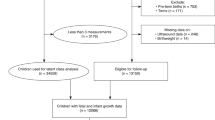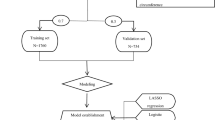Abstract
Objective:
To establish a standard for expected growth of premature infants and generate Z-scores based on the standard.
Study Design:
Multiple regression and analysis of variance were used to evaluate whether the 10th, 50th, and 90th percentiles of birth weight, head circumference, and length from other studies were statistically different from the percentiles from Riddle. Z-scores were generated from the 10th, 50th, and 90th percentiles.
Result:
The growth charts from Mead-Johnson, Babson, Williams, Alexander, Usher, Yudkin, and Fenton were not coincident with the values reported by Riddle. The percentiles reported by Thomas were statistically coincident with the percentiles reported by Riddle.
Conclusion:
The regression equations for the 10th, 50th, and 90th percentile for weight, head circumference, and length provide expected growth of premature infants. The equations can be used to generate expected growth curves and Z-scores for weight, head circumference, and length of premature infants.
This is a preview of subscription content, access via your institution
Access options
Subscribe to this journal
Receive 12 print issues and online access
$259.00 per year
only $21.58 per issue
Buy this article
- Purchase on SpringerLink
- Instant access to full article PDF
Prices may be subject to local taxes which are calculated during checkout





Similar content being viewed by others
References
Ogden CL, Kuczmarski RJ, Flegal KM, Mei Z, Guo S, Wei R et al. Centers for Disease Control and Prevention 2000 growth charts for the United States: improvements to the 1977 National Center for Health Statistics version. Pediatrics 2002; 109 (1): 45–60.
American Academy of Pediatrics Committee on Nutrition, 1984–1985: Mauer AM, Dweck HS, Finberg L, Holmes F, Reynolds JW, Suskind RM et al. Nutritional needs of low-birth-weight infants. Pediatrics 1985; 75 (5): 976–986.
Nutrition Committee, Canadian Paediatric Society. Nutrient needs and feeding of premature infants. CMAJ 1995; 152 (11): 1765–1785.
Engle WA . Age terminology during the perinatal period. Pediatrics 2004; 114 (5): 1362–1364.
Ott WJ . Accurate gestational dating. Obstet Gynecol 1985; 66 (3): 311–315.
Persson PH, Weldner BM . Reliability of ultrasound fetometry in estimating gestational age in the second trimester. Acta Obstet Gynecol Scand 1986; 65 (5): 481–483.
Rossavik IK, Fishburne JI . Conceptional age, menstrual age, and ultrasound age: a second-trimester comparison of pregnancies of known conception date with pregnancies dated from the last menstrual period. Obstet Gynecol 1989; 73 (2): 243–249.
Ballard JL, Khoury JC, Wedig K, Wang L, Eilers-Walsman BL, Lipp R . New Ballard Score, expanded to include extremely premature infants. J Pediatr 1991; 119 (3): 417–423.
Battaglia FC, Lubchenco LO . A practical classification of newborn infants by weight and gestational age. J Pediatr 1967; 71 (2): 159–163.
World Health Organization. Physical status: the use and interpretation of anthropometry. Report of a WHO expert committee, Technical Report Series no. 854. World Health Organization: Geneva,, 1995; 121–160.
Williams RL, Creasy RK, Cunningham GC, Hawes WE, Norris FD, Tashiro M . Fetal growth and perinatal viability in California. Obstet Gynecol 1982; 59 (5): 624–632.
Riddle WR, DonLevy SC, LaFleur BJ, Rosenbloom ST, Shenai JP . Equations describing percentiles for birth weight, head circumference, and length of preterm infants. J Perinatol 2006; 26 (9): 556–561.
Alexander GR, Himes JH, Kaufman RB, Mor J, Kogan M . A United States national reference for fetal growth. Obstet Gynecol 1996; 87 (2): 163–168.
Arbuckle TE, Wilkins R, Sherman GJ . Birth weight percentiles by gestational age in Canada. Obstet Gynecol 1993; 81 (1): 39–48.
Babson SG, Benda GI . Growth graphs for the clinical assessment of infants of varying gestational age. J Pediatr 1976; 89 (5): 814–820.
Battaglia FC, Frazier TM, Hellegers AE . Birth weight, gestational age, and pregnancy out- come, with special reference to high birth weight-low gestational age infant. Pediatrics 1966; 37 (3): 417–422.
Beeby PJ, Bhutap T, Taylor LK . New South Wales population-based birthweight percentile charts. J Paediatr Child Health 1996; 32 (6): 512–518.
Braun L, Flynn D, Ko CW, Yoder B, Greenwald JR, Curley BB et al. Gestational age-specific growth parameters for infants born at US military hospitals. Ambul Pediatr 2004; 4 (5): 461–467.
Brenner WE, Edelman DA, Hendricks CH . A standard of fetal growth for the United States of America. Am J Obstet Gynecol 1976; 126 (5): 555–564.
Cole TJ, Freeman JV, Preece MA . British 1990 growth reference centiles for weight, height, body mass index and head circumference fitted by maximum penalized likelihood. Stat Med 1998; 17 (4): 407–429.
David RJ . Population-based intrauterine growth curves from computerized birth certificates. South Med J 1983; 76 (11): 1401–1406.
Fenton TR . A new growth chart for preterm babies: Babson and Benda's chart updated with recent data and a new format. BMC Pediatr 2003; 3 (1): 13.
Gairdner D, Pearson J . A growth chart for premature and other infants. Arch Dis Child 1971; 46 (250): 783–787.
Gardosi J, Chang A, Kalyan B, Sahota D, Symonds EM . Customised antenatal growth charts. Lancet 1992; 339 (8788): 283–287.
Gardosi J, Mongelli M, Wilcox M, Chang A . An adjustable fetal weight standard. Ultrasound Obstet Gynecol 1995; 6 (3): 168–174.
Gardosi J . Fetal growth: towards an international standard. Ultrasound Obstet Gynecol 2005; 26 (2): 112–114.
Gardosi J, Francis A . A customized standard to assess fetal growth in a US population. Am J Obstet Gynecol 2009; 201 (1): 25.e1–e7.
Gruenwald P . Growth of the human fetus. I. Normal growth and its variation. Am J Obstet Gynecol 1966; 94 (8): 1112–1119.
Gruenwald P . Intra-uterine growth. Pediatrics 1970; 46 (5): 815–817.
Hughes PF . Birthweight/gestational age charts revisited. Aust Paediatr J 1988; 24 (4): 240–243.
Ibe BC, Azubuike JC . Birthweights of preterm Nigerian infants of 26–36 weeks’ gestation. Ann Trop Paediatr 1990; 10 (1): 27–29.
Keen DV, Pearse RG . Intrauterine growth curves: problems and limitations. Acta Paediatr Scand Suppl 1985; 319: 52–54.
Kitchen WH, Robinson HP, Dickinson AJ . Revised intrauterine growth curves for an Australian hospital population. Aust Paediatr J 1983; 19 (3): 157–161.
Kramer MS, Platt RW, Wen SW, Joseph KS, Allen A, Abrahamowicz M et al. A new and improved population-based Canadian reference for birth weight for gestational age. Pediatrics 2001; 108 (2): E35.
Leiberman JR, Fraser D, Weitzman S, Glezerman M . Birthweight curves in southern Israel populations. Isr J Med Sci 1993; 29 (4): 198–203.
Lubchenco LO, Hansman C, Dressler M, Boyd E . Intrauterine growth as estimated from Liveborn birth-weight data at 24 to 42 weeks of gestation. Pediatrics 1963; 32: 793–800.
Lubchenco LO, Hansman C, Boyd E . Intrauterine growth in length and head circumference as estimated from live births at gestational ages from 26 to 42 weeks. Pediatrics 1966; 37 (3): 403–408.
Murphy MA . Standard curves for birth weight. J Reprod Med 1985; 30 (2): 101–105.
Naeye RL, Dixon JB . Distortions in fetal growth standards. Pediatr Res 1978; 12 (10): 987–991.
Niklasson A, Ericson A, Fryer JG, Karlberg J, Lawrence C, Karlberg P . An update of the Swedish reference standards for weight, length and head circumference at birth for given gestational age (1977–1981). Acta Paediatr Scand 1991; 80 (8–9): 756–762.
Olowe SA . Standards of intrauterine growth for an African population at sea level. J Pediatr 1981; 99 (3): 489–495.
Thomas P, Peabody J, Turnier V, Clark RH . A new look at intrauterine growth and the impact of race, altitude, and gender. Pediatrics 2000; 106 (2): E21.
Tin W, Wariyar UK, Hey EN . Selection biases invalidate current low birthweight weight-for-gestation standards. The Northern Neonatal Network. Br J Obstet Gynaecol 1997; 104 (2): 180–185.
Usher R, McLean F . Intrauterine growth of live-born Caucasian infants at sea level: standards obtained from measurements in 7 dimensions of infants born between 25 and 44 weeks of gestation. J Pediatr 1969; 74 (6): 901–910.
Wilcox M, Gardosi J, Mongelli M, Ray C, Johnson I . Birth weight from pregnancies dated by ultrasonography in a multicultural British population. BMJ 1993; 307 (6904): 588–591.
Yudkin PL, Aboualfa M, Eyre JA, Redman CW, Wilkinson AR . New birthweight and head circumference centiles for gestational ages 24 to 42 weeks. Early Hum Dev 1987; 15 (1): 45–52.
Zhang J, Bowes Jr WA . Birth-weight-for-gestational-age patterns by race, sex, and parity in the United States population. Obstet Gynecol 1995; 86 (2): 200–208.
Babson SG, Behrman RE, Lessel R . Fetal growth. Liveborn birth weights for gestational age of white middle class infants. Pediatrics 1970; 45 (6): 937–944.
Farr V, Kerridge DF, Mitchell RG . The value of some external characteristics in the assessment of gestational age at birth. Dev Med Child Neurol 1966; 8 (6): 657–660.
Patel AL, Engstrom JL, Meier PP, Kimura RE . Accuracy of methods for calculating postnatal growth velocity for extremely low birth weight infants. Pediatrics 2005; 116 (6): 1466–1473.
Bose C, Van Marter LJ, Laughon M, O’Shea TM, Allred EN, Karna P et al. Fetal growth restriction and chronic lung disease among infants born before the 28th week of gestation. Pediatrics 2009; 124: e450–e458.
Slining MM, Adair L, Goldman BD, Borja J, Bentley M . Infant temperament contributes to early infant growth: a prospective cohort of African American infants. Int J Behav Nutr Phys Act 2009; 6: 51.
Ross ES, Krebs NF, Shroyer AL, Dickinson LM, Barrett PH, Johnson SL . Early growth faltering in healthy term infants predicts longitudinal growth. Early Hum Dev 2009; 85 (9): 583–588.
Madden J, Kobaly K, Minich NM, Schluchter M, Wilson-Costello D, Hack M . Improved weight attainment of extremely low-gestational-age infants with bronchopulmonary dysplasia. J Perinatol 2010; 30 (2): 103–111.
Huh SY, Feldman HA, Cox JE, Gordon CM . Prevalence of transient hyperphosphatasemia among healthy infants and toddlers. Pediatrics 2009; 124 (2): 703–709.
Martin CR, Brown YF, Ehrenkranz RA, O’Shea TM, Allred EN, Belfort MB et al. Nutritional practices and growth velocity in the first month of life in extremely premature infants. Pediatrics 2009; 124 (2): 649–657.
Larsen PV . Module 9: comparing regression lines, ST111: regression and analysis of variance, Department of Statistics, University of Southern Denmark, J. B. Winsøws Vej 9, DK-5000 Odense C, Denmark. http://statmaster.sdu.dk/courses/st111/. Downloaded on 9 February 2009, 2006.
Author information
Authors and Affiliations
Corresponding author
Ethics declarations
Competing interests
The authors declare no conflict of interest.
Rights and permissions
About this article
Cite this article
Riddle, W., DonLevy, S. Generating expected growth curves and Z-scores for premature infants. J Perinatol 30, 741–750 (2010). https://doi.org/10.1038/jp.2010.32
Received:
Revised:
Accepted:
Published:
Issue date:
DOI: https://doi.org/10.1038/jp.2010.32
Keywords
This article is cited by
-
Novel noninvasive anthropometric measure in preterm and full-term infants: normative values for waist circumference:length ratio at birth
Pediatric Research (2013)
-
The long-term renal and cardiovascular consequences of prematurity
Nature Reviews Nephrology (2012)



